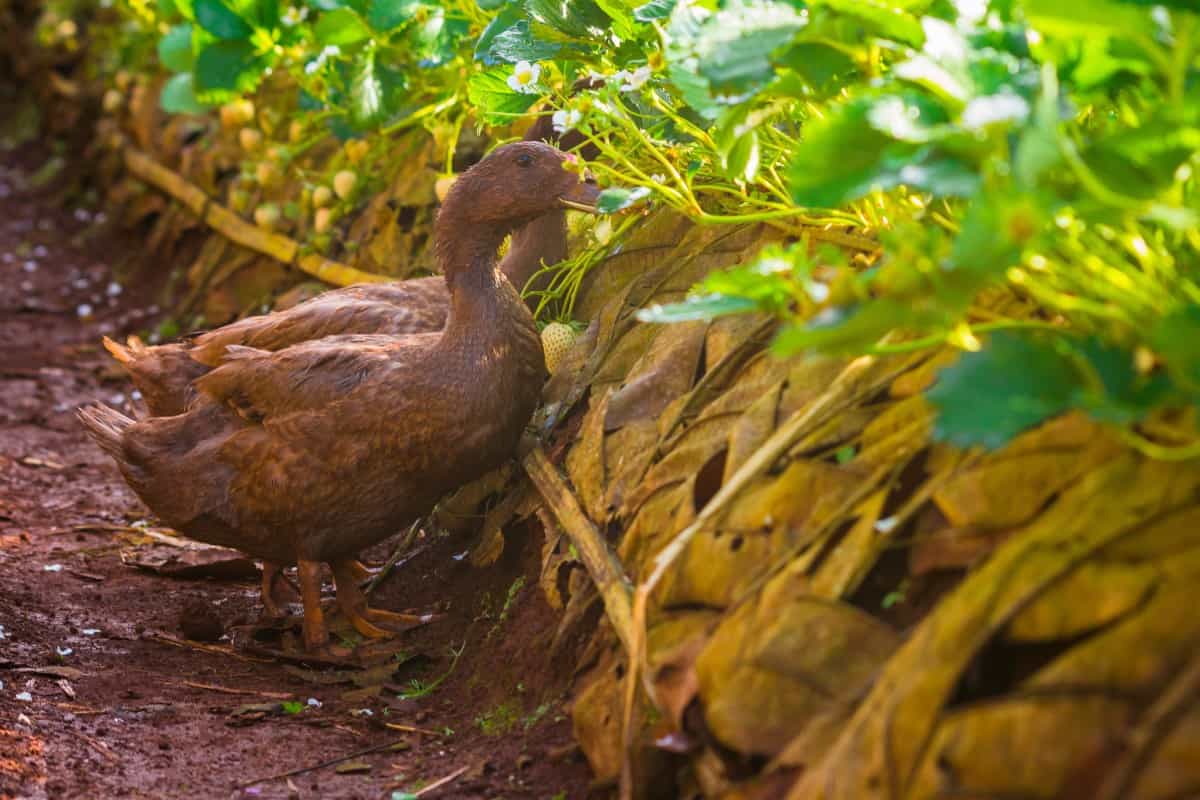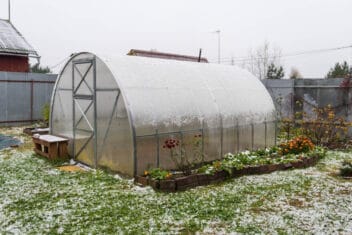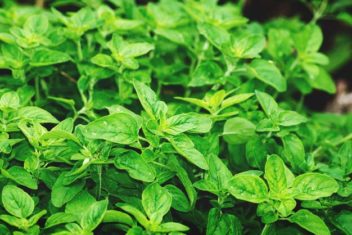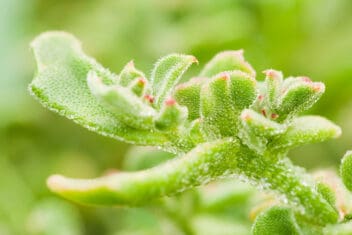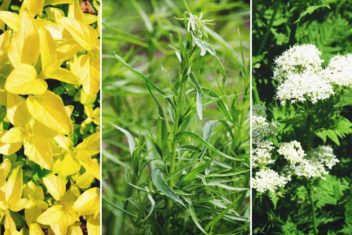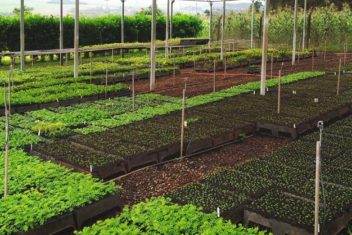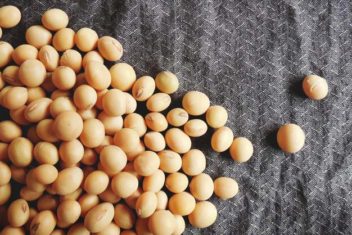Did you know that ducks are great garden helpers? They can improve soil, eat pests (particularly slugs and snails), and help control weeds. Also, by putting them to work in the garden they can partially feed themselves to keep your duck care costs in check.
Plus, gardening with ducks is fun and relaxing. Who doesn’t want to spend a sunny afternoon puttering around in the garden with the ducks, delighting in their antics?
Of course, you can’t just let ducks trample your new seedlings or run wild in your tomato plot. You’ll need to make a few adjustments to your garden design and what you grow. However, with just a little preparation, you can make a duck-friendly garden.
What is a Duck-Friendly Garden?
Let’s start by defining what a duck-friendly garden is and isn’t.
1. Kid Friendly Comparison
To me, calling a garden duck-friendly is like when a hotel or restaurant calls itself kid-friendly. That term means those places allow children. They may also have a few amenities for kids like a pool or free crayons. However, that hotel or restaurant is still geared primarily for adults to enjoy.
In other words, it really means well-behaved kids are welcome but don’t expect an amusement park atmosphere.
2. Duck Amusement Park
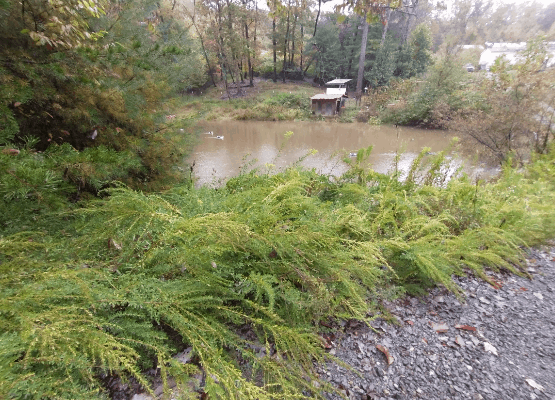
So, when I say duck friendly garden, I’m not talking about a duck amusement park. If you want to make one of those, Permaculture landscapes, food forests, or perennial edible landscapes are the way to go.
A duck amusement-park-type garden would have a pond. There would be trees that drop fruits and nuts and leafy plants to nibble on. Oh, and don’t forget the smorgasbord of slugs, snails, mosquito larva, and grasshoppers.
A duck friendly garden, by contrast, is more about making your garden – designed for growing plants – a place where ducks are welcome as long as they are well-behaved and have duck-keeper supervision.
An Example of a Duck Friendly Garden
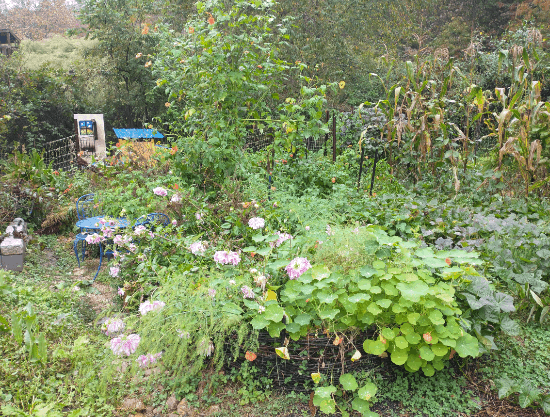
Since you’re reading about duck friendly gardens on MorningChores, I am going to bet that you desire to have some vegetables in your duck friendly garden. You’ll likely also have herbs and maybe a few spices.
Perhaps you can fit in some fruit trees and perennial edibles such as horseradish, rhubarb, and asparagus. Of course, there must be flowers too – some edible (e.g. nasturtiums, sunflowers, hollyhocks) and some just beautiful for enjoying and cutting (e.g. dahlias, peony, zinnia).
If this is the kind of garden you want to make duck friendly, then let’s talk about ways to make that dream a reality.
#1 Choose the Right Duck Breeds
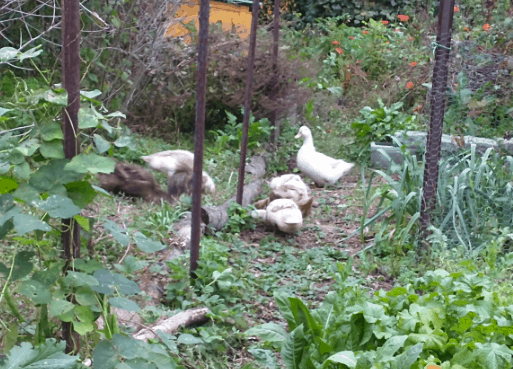
The first step to making your garden duck friendly is to keep the right kind of ducks.
1. Not So Ideal Ducks
Most domesticated breeds can work well in a duck friendly garden. However, there are two breeds I’d suggest new duck keepers don’t keep until they have a little more experience keeping ducks.
– Muscovy Ducks
Muscovy ducks are flyers. Even if you clip their wings, they will find ways to breach low barriers. So, these lovely birds don’t make the best garden ducks because you’ll need to do more work to protect plants from these determined ducks.
– Mallard Ducks
Mallard ducks are another not so ideal choice because they also enjoy flying. Mallards are also exceptional foragers. That makes them more likely to make meals out of plants you’d prefer to eat yourself.
2. Better Garden Ducks
Now that I’ve warned you about the two more challenging breeds to avoid, let’s look at breeds more likely to be good garden-friendly ducks.
– Runner Ducks
Runner ducks are an ideal choice because they are lightweight. They are more upright than other ducks so they take up less room in pathways. They are also easy to herd.
– Heavy Ducks
My favorite ducks for garden use, though, are the heavier breeds. Pekins don’t like to climb over obstacles. Instead, they stick to obvious paths. That makes it much easier to protect plants just by creating barriers they won’t want to climb over.
Rouen, Ancona, Cayuga, and White Crested ducks are some other favorites of mine because they are so beautiful. These ducks are also easy to socialize and use as garden companions.
– Light Weight Ducks
Lighter weight breeds like the Khaki Campbells, Welsh Harlequins, and the Swedish duck breeds are also lovely garden helpers. These ducks can maneuver over obstacles with more ease than some of the heavier breeds. However, they are so sweet and adorable, it’s well worth a little extra work to protect plants.
#2 Plan for Access

The next thing you need to do to make your garden duck friendly is to plan for how and when ducks will have access to your garden. In a duck amusement park kind of garden, ducks can run wild all the time. However, in a duck friendly garden, you need more control over when ducks do and don’t go into the garden.
If you put a duck run inside or adjacent to a fenced garden, then letting them into the garden might be as simple as opening a gate and herding ducks to part of the garden. That also makes it easy to herd them back into their run, out of the garden, when necessary.
If your duck living quarters are far away from your garden, you can likely lure them to the garden with a bucket of food. Still, getting them back out will be the hard part.
1. Well-Timed Visits
You can either become a skilled duck herder, or you can plan duck garden visits for late afternoon or evening. That way ducks will naturally want to gravitate back toward their duck house in the dark.
2. Build a Dunnel?
If you want to get really fancy, you could even build a dunnel – the duck version of a chicken tunnel – to connect your garden to your duck area.
Just make sure you have a plan to get ducks out of the garden before they do any irreparable damage to your plants. That way your ducks will never overstay their welcome.
#3 Protect Plants
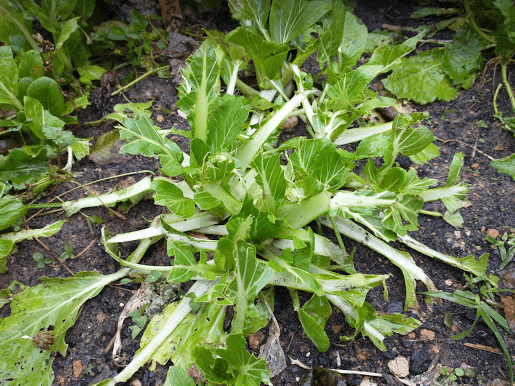
The next step to making your garden duck friendly is to protect plants that need it. How much protection a plant needs will depend on the plant and its stage in life. Here are some ideas to give you a little direction.
1. Transplants and Seedlings
All seedlings, or recent transplants, will require protection from ducks. It’s really important to make sure plants don’t get trampled or root systems disturbed before they establish.
For these young plants that will need temporary protection only, things like row covers or cloches can be a perfect solution. You can also put up a temporary plastic or electric fence if you are turning a section of your beds or rows.
2. Plants Ducks Love
There are also some plants that you’ll need to protect from ducks for their entire lifespan. For example, it’s no big deal if ducks nibble on a mature mustard plant’s leaves. The plant will just grow more.
Even so, if you are growing baby bok choy to cook whole (for a beautiful plate presentation) you can’t let ducks dine on those leaf tips. Oh, and they will (as evident in the image above) since they love bok choy! So protect plants like those until harvest.
Ducks also love young potato leaves. The potato plant will usually recover even if completely defoliated. However, it will delay your harvest since the plant must focus on new leaf growth over tuber production.
3. Long-Term Duck Protection
For long-term plant protection, you may have to think beyond row covers and cloches into more permanent solutions. Here are some of my favorites.
– Use Containers
Grow more delicate plants in containers. Then place those containers on blocks or stacked rocks to elevate them so ducks can’t reach them.
– Install Borders Around Beds
Another technique to discourage ducks from damaging tender plants is to make a protective border around the beds. Think of these as mini-fences not raised beds.
These bed borders need to be at least bill height when your duck is standing upright. I usually go for about 10-12-inches so they work for whatever breed I have at the time. You don’t want them too tall though, or the borders may cast shade on the plants growing in the bed.
This raised border method works because ducks don’t like to step over narrow objects. They’ll easily climb over a wide log or a big rock. However, they’ll go out of their way to avoid climbing over a flat board standing on its side.
So, by using borders that act as mini-fence they have to climb over, rather than a raised bed they can climb on top of, you encourage them to move on to easier accessible pastures.
– Extra Tall Raised Beds
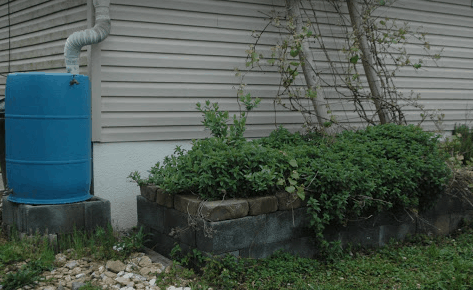
You can also use raised beds. They just need to be tall enough that ducks can’t climb into them. For most of my ducks, 2.5-3-feet tall beds usually deter them from getting my plants. Shorter beds simply don’t work though.
– Short Fences
You can also install a short fence to block off part of your garden area to limit where ducks go. A 2-3-foot fence that you can step over without opening gates will easily discourage ducks that don’t fly (or don’t like to).
Since these are just duck prevention fences and not being used to keep out things like deer, they don’t have to be heavy-duty. In fact, they are the perfect opportunity to make decorative fences out of scavenged stuff or scrap materials from other projects.
– Use Mini-Hedges
Another option that’s lovely, though it does require more time and planning, is to make mini-hedges around the duck no-go zones. These mini-hedges can be permanent features made from evergreen plants.
Or… they can be quick-growing plants used to mask and dissuade ducks from tastier treats behind. It takes a little experimentation to find out what works as a duck hedge.
So far, my ducks have been discouraged by hedges of several kinds of basil, lemon balm, and broadleaf plantain.
My failures were green onions and rosemary. The ducks ate the onion tops, while they absolutely loved lounging around in the rosemary.
#4 Plan to Share
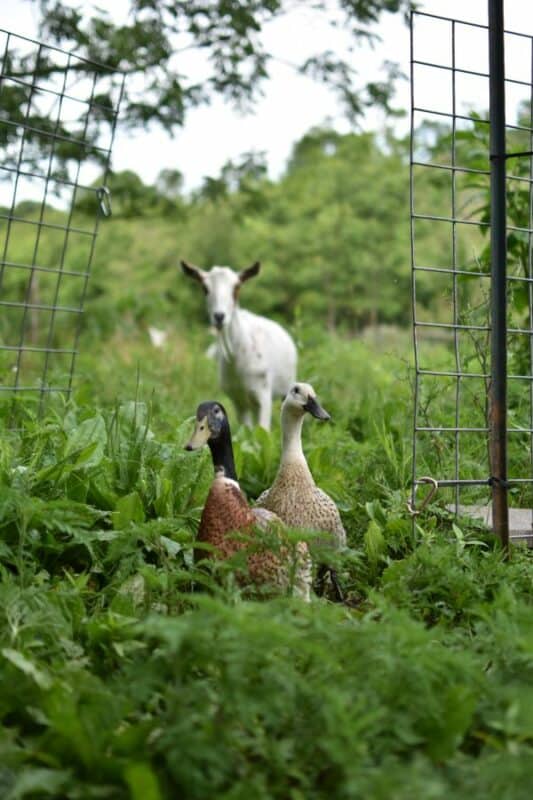
If you don’t want to have to protect lots of plants at once, you can also plant things that aren’t as likely to be harmed by ducks.
1. Comfrey
For example, I use comfrey as a green manure in my garden. That plant grows so abundantly that I don’t mind sharing some of the leaves with the ducks. Plus, it’s a duck favorite.
2. Prolific Producers
Ducks are also welcome to all the mint, horseradish leaves, Jerusalem artichoke tops, or even true artichoke and cardoon leaves they want. In late summer when the sweet potato vines start to swallow half my garden, it’s a pleasure to see the ducks munching on the new leaf tips crossing into my paths.
Ducks like to eat all of these plants. However, the plants are such prolific producers, by nature, ducks don’t seem to endanger their health or reduce my harvests.
3. Fruit
My ducks are always welcome under my grapevines. There they eat the leaves that sprout from the trunk or dangling growth that I’ll eventually prune anyhow.
I also share some of my blackberries with my ducks. They eat the fruit that grows closer to the ground. I get the fruit higher up on the plant.
By giving ducks easy access to edible options you don’t mind sharing you won’t have to go to so much trouble protecting precious plants.
#5 Go Vertical
There are also lots of plants that can be grown in such a way the ducks can’t reach the tasty parts. Vertically grown squash or cucumbers are good options. Also, taller plants like corn, amaranth, sunflowers, or sorghum tend to be safe choices.
1. Beans and Peas
Additionally, if you have options between trellis type or bush type plant varieties, go pole.
For example, beans and peas come in bush or pole varieties. The bush type will need to be protected from ducks. While the pole type grows up poles where ducks can’t reach.
2. Tomatoes
Tomatoes also come in bush or vining types. By selecting a vining variety and training them up, you can reduce duck access. Keep in mind though, you will still need to protect your plants until they are established.
Using Ducks in the Garden
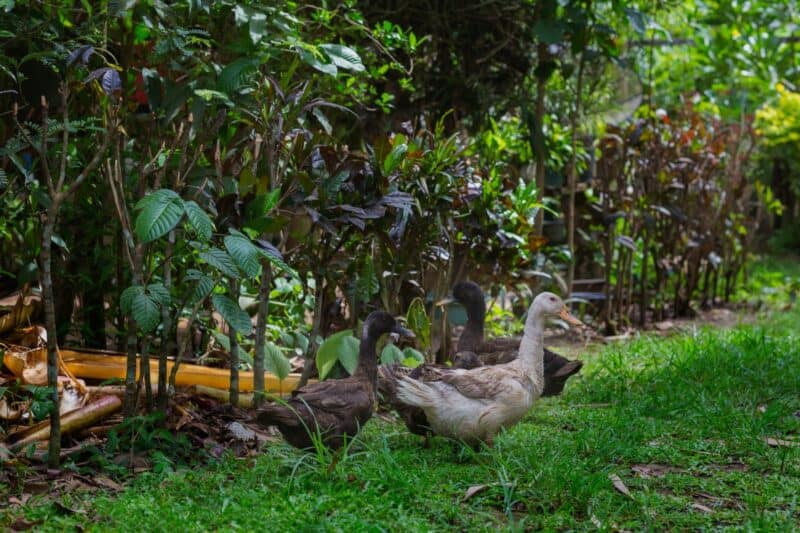
Now that you know some tricks to make your garden duck friendly, let’s get into a few ways you can put your ducks to work in your garden.
1. Slug Removal
My number one favorite way to use ducks in the garden is for slug removal.
Slugs like to hide during the day. So, if you have an area that is heavy loaded with slugs, put a board down alongside the plants they are eating at night.
Then, bring in the ducks around mid-morning. Flip over the board and let the ducks feast on the smorgasbord of slugs hiding underneath.
2. Bed Prep
Whenever I turn the beds, I also like to bring in the ducks. First, though, I pull up any crop residues left in the bed and lay it out on the soil as mulch. I water it. Then I let it sit for a couple of days.
After that, I bring over the ducks and lift up those crop residues. There are always lots of worms, slugs, pillbugs, and more under those leaves. The ducks eat the slow movers who can’t hide in the soil quickly.
Additionally, once they’ve eaten all the good stuff, if you water the soil to make it muddy, they’ll dabble in the bed. As they linger, dabbling and dining, they also drop manure and do a little light tilling for you.
– Manure Safety Reminder
Keep in mind fresh manure may contain pathogens. So, you may not wish to use your ducks to prep a lettuce bed.
They’re great for long season crops like winter squash or sesame. This method can also be used for things like staked peppers or okra where the food portion of the plant won’t ever touch the soil.
3. Trench Composting
Another thing I love to do is trench composting.
Whenever I dig the trench, I let the ducks “help”. They hang out with me eating up the grubs and wireworms in the exposed soil. They also drop manure in the trench that will be composted along with my kitchen scraps and other compostables.
4. Weed Reduction
Ducks aren’t perfect weeders. So, you’ll need to give them some help. However, I’ve discovered that they love henbit, dead nettle, chickweed, bittercress, dandelion, clover, many kinds of grass, and more.
If I scatter a bit of food over a weedy part of the garden, they’ll eat the food and many of the weeds in the area too. If I use my hand rake or hoe to loosen the weeds first, they do an even better job weeding.
5. Seed Reduction
Ducks are also seed eaters too. If I accidentally let something go to seed, I can bring in the ducks to do seed reduction. They particularly seem to like allium family seeds (chives, onions, leeks) and annual grass seeds.
6. Directed Dining
I also frequently pile up my spent plants on weedy patches in my garden paths to smother weeds. Eventually, I move that stuff to the compost pile. However, until I do, I direct the ducks to my path piles.
There they eat some weeds and the insects the pile attracts. Plus, they add poop to the pile that I can later compost.
Final Advice for a Duck-Friendly Garden
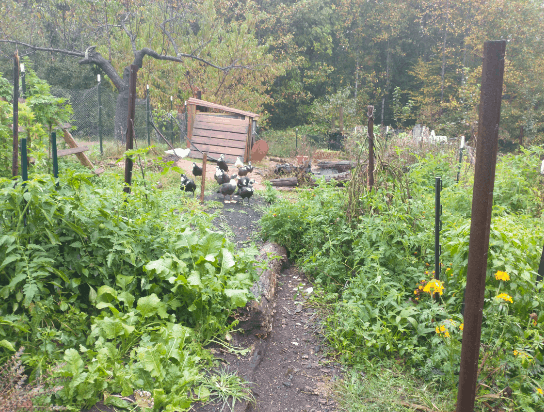
These 13 ducklings above currently live in one of the vegetable gardens and do very little damage at this age. However, in a few weeks, I’ll put up a short fence to keep them out of the vegetable patch. Otherwise, they’ll start to decimate my crops!
I genuinely believe that every garden can be made duck friendly and benefit from being visited by ducks. However, there’s one last thing that has to be said.
Just like hotels and restaurants have occupancy limits, so should your garden! Even though I completely understand your burning desire to have a few dozen ducks following you around the garden, always remember the garden is first and foremost a place to grow plants!
Right size your duck population, and the amount of time they spend, to the size and health of your garden.
